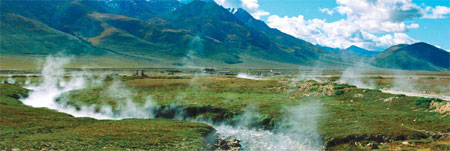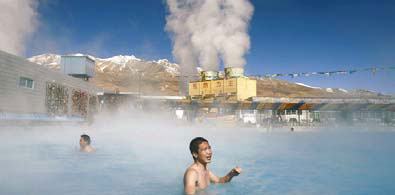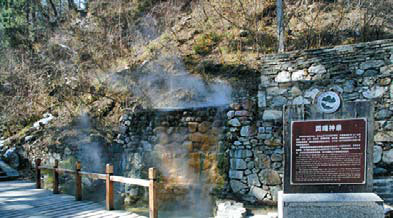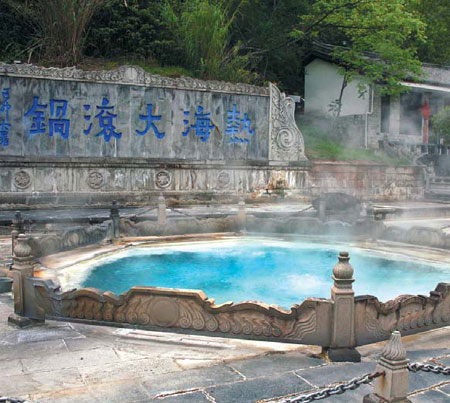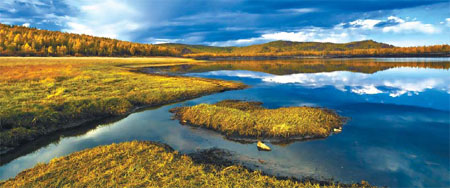Getting Into Hot Water
Updated: 2012-10-07 07:54
(China Daily)
|
|||||||
|
The Yangbajing section of the Qinghai-Tibet Highway is full of geothermal resources and harbors some of Tibet's best spas. Gan Zhanglin / for China Daily |
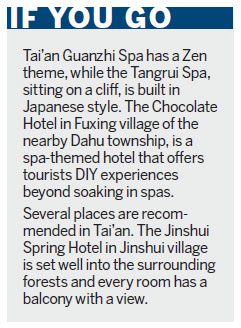
Get a good soak during the holidays and let the steaming hot water soothe away all the stress of the daily grind in the cities. Seek out the recuperative cures at China's most well-known hot springs holiday destinations. We take you on a quick tour.
Editor's note: From Sichuan to Tengchong, from Lhasa to Inner Mongolia to Taiwan's Miaoli County, China's hot spring centers offer plenty of opportunities to kick back and relax. Whichever direction you may choose to go, there is always a warm welcome waiting.
Tai'an, Taiwan
Tai'an in Taiwan's Miaoli county has always been popular for its numerous hot springs, mainly situated along the Wenshuixi River in a village called Jinshui. Here visitors can luxuriate in high-quality hot springs while feasting their eyes on beautiful landscapes. Local-flavored dishes and ethnic culture are extra attractions.
The hot springs at Tai'an have a long history. Unlike sulfurous hot springs, which are often turbid and pungent, the sodium bicarbonate springs here are milky white and translucent.
Apart from the usual recuperative benefits, the hot springs here are also believed to have cosmetic qualities, hence their name, the "Beauty Springs".
All kinds of value-added facilities include outdoor pools, plus intricately landscaped gardens full of artificial rock hills and waterfalls. Specially designed lighting turns them into a fairyland at night.
Most of the bathrooms at hotels or inns here are directly connected to spring water, so you can simply turn on the tap and enjoy a carefree spa in the room.
|
Hot springs play an important role in traditional Tibetan medicine. Peter Parks / for China Daily |
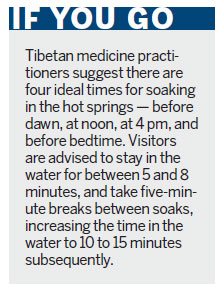
Lhasa, Tibet
Besides the numerous myths that surround them, hot springs in Tibet play an important role in traditional Tibetan medicine, both as therapy and as part of the wellness routine.
The Qiusang Hot Spring, located along the Yangbajing section of the Qinghai-Tibet Highway, is one of Tibet's best spas.
In the past, both commoners and nobility frequented the hot spring, and it is still relatively in its original state, with only two small stone houses serving as bathrooms.
But the Dezhong Hot Spring, about 120 km away from Lhasa, is the most convenient. Buses depart every other day at 7 am from the East Lhasa Guest Station. The return bus leaves at the same time.
This hot spring sits at the bottom of a valley and boasts a three-story wooden hotel next door. A double room costs only 30 yuan, and guests do not have to pay the additional 5 yuan charged for the use of the hot spring.
If you are planning to stay overnight, it may be best to pack a picnic as the only restaurant here serves only simple Tibetan noodles and other instant foods.
At Medro Gongkar County, there are two other hot springs. Riduo has a history of several centuries, and is on the altitude as the Dezhong Hot Spring. Both have the same water quality.
The water temperature at the spring source of Riduo can reach as high as 81C, but in spite of that, there is a harmless little worm living in the water which the locals call "holy worms".
|
Minya Konka Hot Spring lies in the scenic Hailuogou area. Jing Aiping /for China Daily |
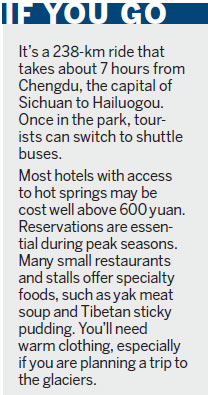
Hailuogou, Sichuan
Hailuogou scenic area in Sichuan province boasts many natural springs, with water temperatures ranging from boiling hot to icy cold. The water is of excellent quality here, and tourist can drink from springs, free from pollution and impurities, generously scattered along the main entrance road and the other accessible paths in the park.
But to soak in the springs, you may want to head for the Minya Konka Hot Spring, which has a big swimming pool and several smaller hot-spring pools. Minya Konka is only 7 km from the park entrance.
Another excellent hot spring is near the park's Campsite No 1, halfway between the Minya Konka Hot Spring and Campsite No 2.
Hosts of monkeys are often seen along the main drive in the park, and you can enjoy a dramatic change of scenery as the road climbs, especially when you go in winter.
The hot spring at Campsite No 2, where the renowned Heavenly Pool is located, is the most famous in Hailuogou. Here, there are many wooden cabins, restaurants and bars, all of which seem to blend into the surrounding scenery. Nearly every cabin has its own little hot spring pool.
If you prefer company, there is a series of hot springs as well as a swimming pool just next to the accommodation cluster. It's worth a visit even in the chill of winter.
Spring water here is rich in calcium, and a favorite pastime among visitors is to try to cook soft-boiled eggs here.
Monkeys also provide free entertainment, gathering around the cabins in the hope of food and play. In fact, they have become an attraction in themselves.
|
The Hot Sea Hot Spring is the largest of its kind in Tengchong. Peng Nian / for China Daily |
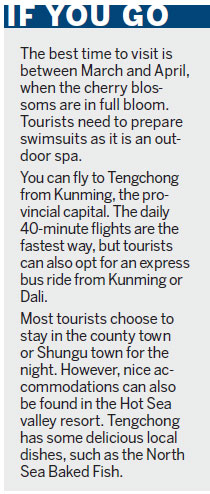
Tengchong, Yunnan
The little frontier town of Tengchong in Yunnan combines mesmerizing elements from a volcano, forests, wetlands to native color. It also has the richest hot spring resources in the whole of China.
The Hot Sea Hot Spring, about 30 km away from the county town, is the largest of its kind in Tengchong. Built in the national geothermal park, the spring's water is rich in minerals, such as sulfur, iron, and silicon. The well-equipped resort has a swimming pool and a number of independent outdoor or indoor spas. There is a luxurious hotel in the park, too.
Cheaper and quieter spas are also popular. The Huangguaqing Hot Spring, for example, is preferred by many for its location in a valley that is green all year round.
Here, a special bathing ritual is strictly adhered to.
A steam bath comes first. The steam holes on the bed are laid with sand and cobblestones before they are covered by a thick layer of fresh pine leaves and herbs. Finally, a grass mat is laid on top. The visitor lies down with a blanket.
As the steam gathers heat, perspiration begins to flow and a little rubbing down will help cleanse the pores.
A soak in the spring water then refreshes and soothes away the stress.
The Cherry Blossoms Valley Spa, about 30 km from Tengchong, is an all-natural outdoor spa.
Aershan, Inner Mongolia
The Haishen Shengquan Tourist Resort in the Aershan city is a famous spa destination in China.
It is located in the Aershan National Geopark, under the administration of the Hinggan League in Inner Mongolia autonomous region.
Four hot-spring regions have been found here, and the 76 springs in total have been categorized into cold springs, warm springs, hot springs, and high-heat springs.
Some 48 springs are scattered along a grassland area about 500 meters long and 70 meters wide, with water temperatures ranging from 2 to 48 C. The waters are rich in trace elements and are believed to be highly beneficial to health.
It is said that different springs offer cures for different ailments, including rheumatic arthritis, trichophytia, high acid gastritis and neuro-dermatitis, among others.
There are several options for spas here. The one with the best facilities is the Spring Museum of China, which is also the most expensive - about 300 yuan per head. There are public baths in the museum, so tourists need to bring swimsuits.
Another spa is called Jinjianggou Valley, an outdoor bath that is close to a forest park. It offers the cheapest spas, at 80 yuan each. There are also simple but cheap hotels nearby.
Adapted from an original story which first appeared in Traveler magazine.
|
Besides the mesmerizing landscape, Aershan is a famous hot-spring destination. Mu Jun / for China Daily |
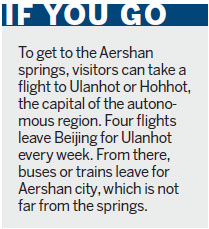
(China Daily 10/07/2012 page10)
